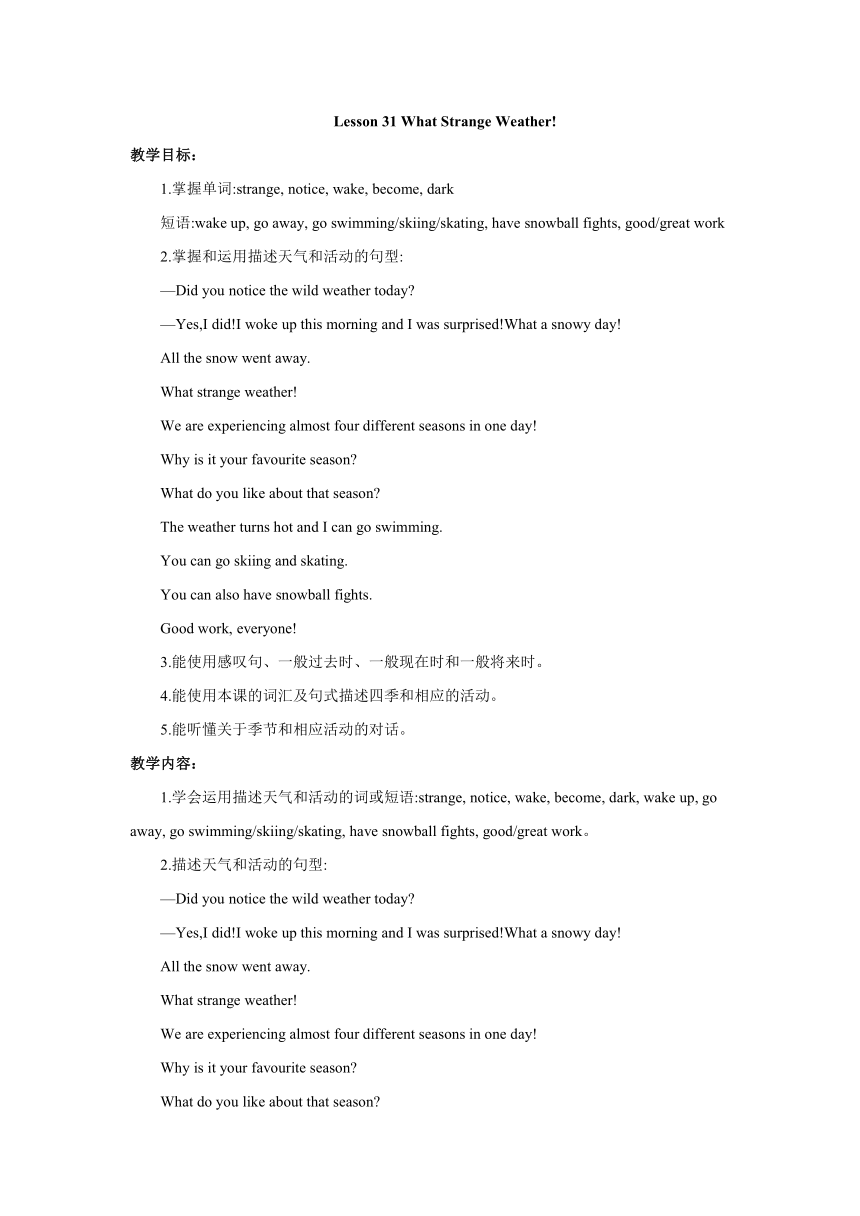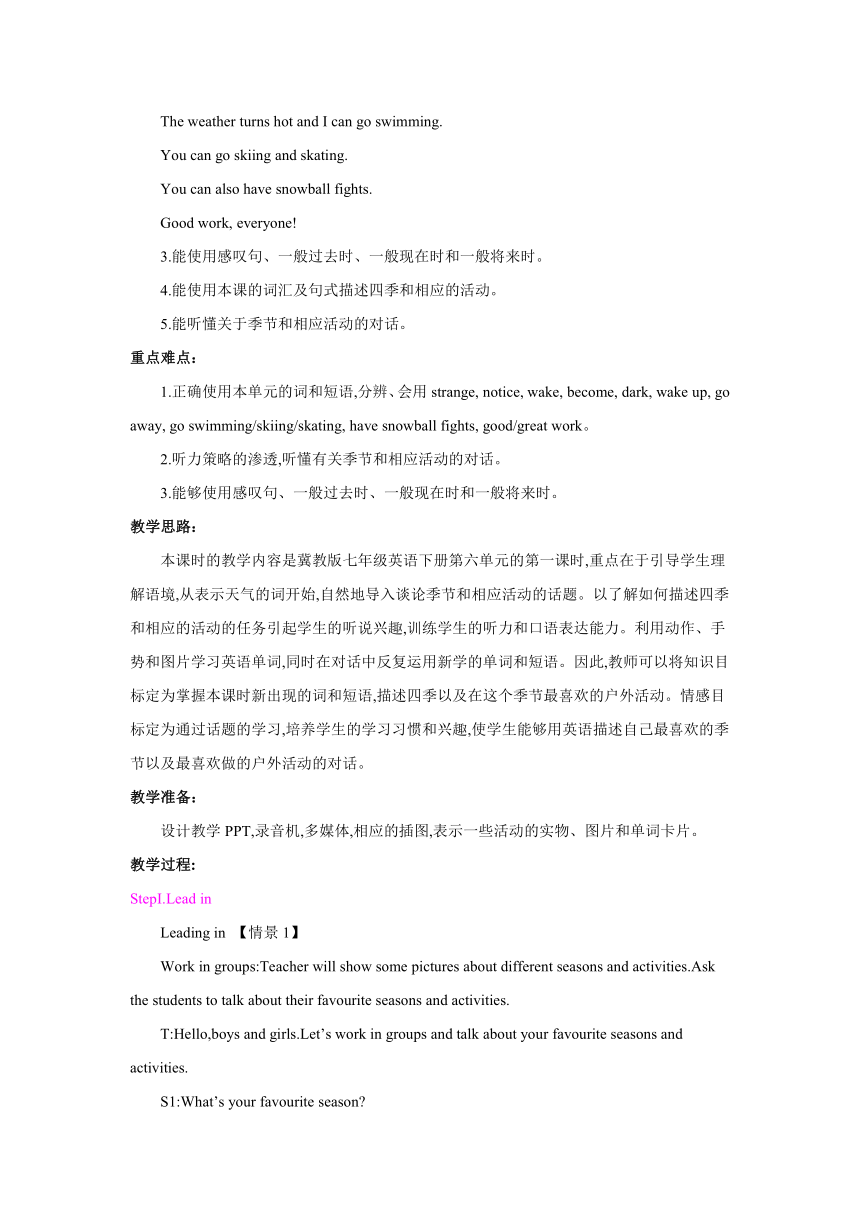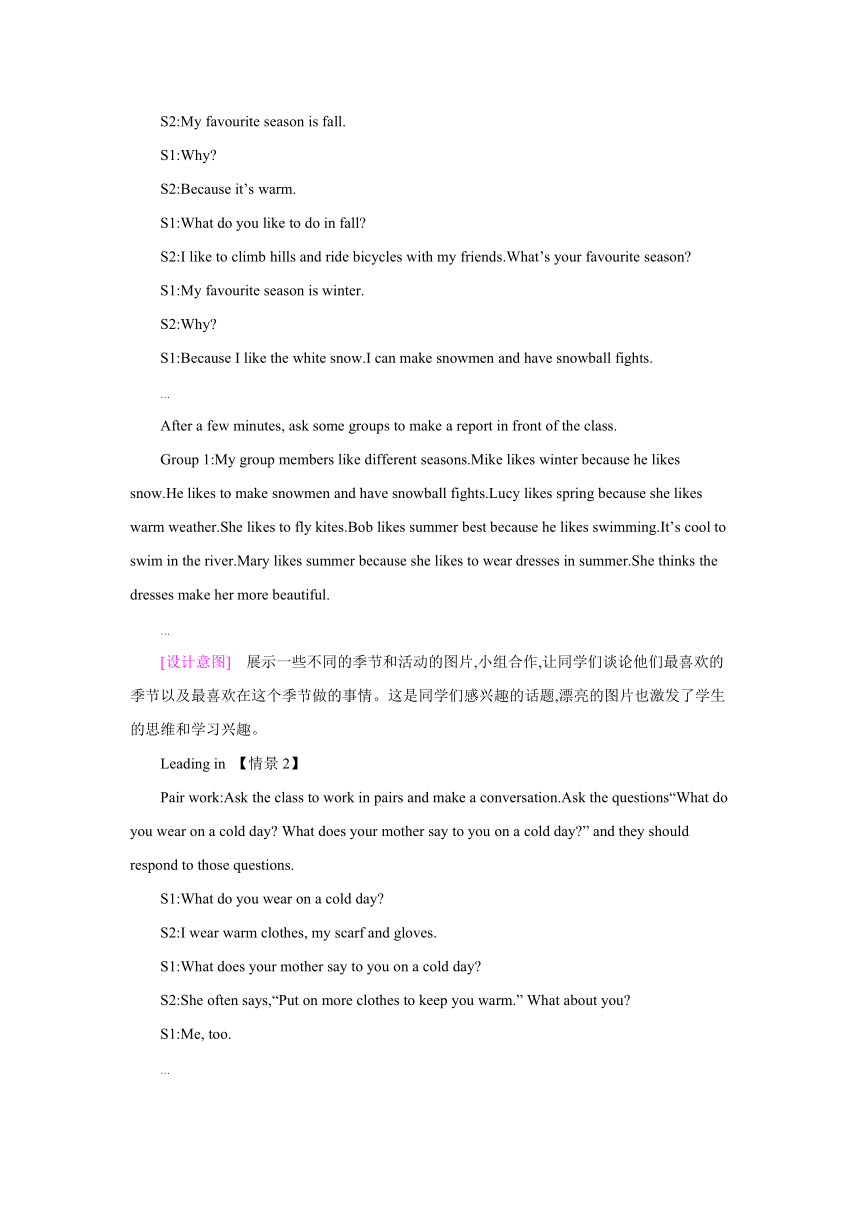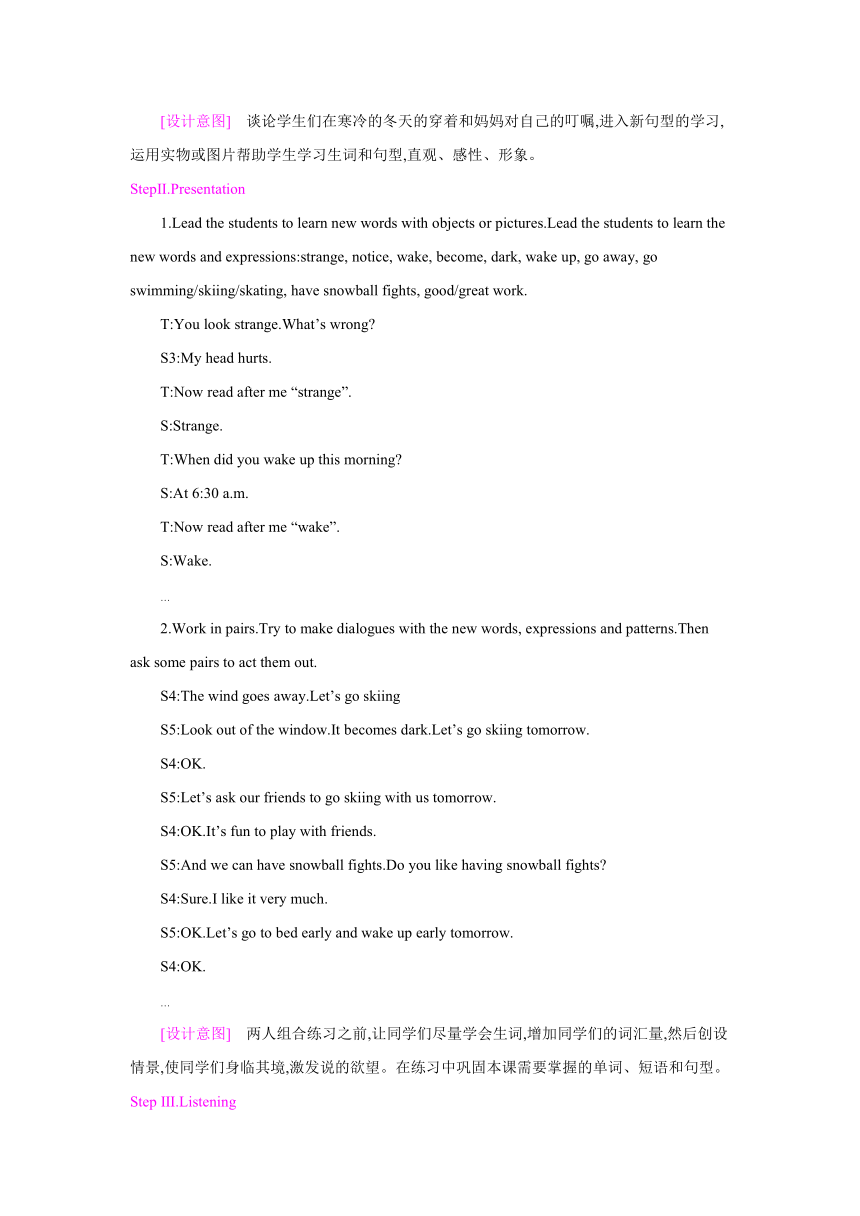Unit 6 Seasons Lesson 31 What Strange Weather! 教学设计
文档属性
| 名称 | Unit 6 Seasons Lesson 31 What Strange Weather! 教学设计 |  | |
| 格式 | zip | ||
| 文件大小 | 27.5KB | ||
| 资源类型 | 教案 | ||
| 版本资源 | 冀教版 | ||
| 科目 | 英语 | ||
| 更新时间 | 2019-06-27 17:14:56 | ||
图片预览




文档简介
Lesson 31 What Strange Weather!
教学目标:
1.掌握单词:strange, notice, wake, become, dark
短语:wake up, go away, go swimming/skiing/skating, have snowball fights, good/great work
2.掌握和运用描述天气和活动的句型:
—Did you notice the wild weather today?
—Yes,I did!I woke up this morning and I was surprised!What a snowy day!
All the snow went away.
What strange weather!
We are experiencing almost four different seasons in one day!
Why is it your favourite season?
What do you like about that season?
The weather turns hot and I can go swimming.
You can go skiing and skating.
You can also have snowball fights.
Good work, everyone!
3.能使用感叹句、一般过去时、一般现在时和一般将来时。
4.能使用本课的词汇及句式描述四季和相应的活动。
5.能听懂关于季节和相应活动的对话。
教学内容:
1.学会运用描述天气和活动的词或短语:strange, notice, wake, become, dark, wake up, go away, go swimming/skiing/skating, have snowball fights, good/great work。
2.描述天气和活动的句型:
—Did you notice the wild weather today?
—Yes,I did!I woke up this morning and I was surprised!What a snowy day!
All the snow went away.
What strange weather!
We are experiencing almost four different seasons in one day!
Why is it your favourite season?
What do you like about that season?
The weather turns hot and I can go swimming.
You can go skiing and skating.
You can also have snowball fights.
Good work, everyone!
3.能使用感叹句、一般过去时、一般现在时和一般将来时。
4.能使用本课的词汇及句式描述四季和相应的活动。
5.能听懂关于季节和相应活动的对话。
重点难点:
1.正确使用本单元的词和短语,分辨、会用strange, notice, wake, become, dark, wake up, go away, go swimming/skiing/skating, have snowball fights, good/great work。
2.听力策略的渗透,听懂有关季节和相应活动的对话。
3.能够使用感叹句、一般过去时、一般现在时和一般将来时。
教学思路:
本课时的教学内容是冀教版七年级英语下册第六单元的第一课时,重点在于引导学生理解语境,从表示天气的词开始,自然地导入谈论季节和相应活动的话题。以了解如何描述四季和相应的活动的任务引起学生的听说兴趣,训练学生的听力和口语表达能力。利用动作、手势和图片学习英语单词,同时在对话中反复运用新学的单词和短语。因此,教师可以将知识目标定为掌握本课时新出现的词和短语,描述四季以及在这个季节最喜欢的户外活动。情感目标定为通过话题的学习,培养学生的学习习惯和兴趣,使学生能够用英语描述自己最喜欢的季节以及最喜欢做的户外活动的对话。
教学准备:
设计教学PPT,录音机,多媒体,相应的插图,表示一些活动的实物、图片和单词卡片。
教学过程:
StepⅠ.Lead in
Leading in 【情景1】
Work in groups:Teacher will show some pictures about different seasons and activities.Ask the students to talk about their favourite seasons and activities.
T:Hello,boys and girls.Let’s work in groups and talk about your favourite seasons and activities.
S1:What’s your favourite season?
S2:My favourite season is fall.
S1:Why?
S2:Because it’s warm.
S1:What do you like to do in fall?
S2:I like to climb hills and ride bicycles with my friends.What’s your favourite season?
S1:My favourite season is winter.
S2:Why?
S1:Because I like the white snow.I can make snowmen and have snowball fights.
…
After a few minutes, ask some groups to make a report in front of the class.
Group 1:My group members like different seasons.Mike likes winter because he likes snow.He likes to make snowmen and have snowball fights.Lucy likes spring because she likes warm weather.She likes to fly kites.Bob likes summer best because he likes swimming.It’s cool to swim in the river.Mary likes summer because she likes to wear dresses in summer.She thinks the dresses make her more beautiful.
…
[设计意图] 展示一些不同的季节和活动的图片,小组合作,让同学们谈论他们最喜欢的季节以及最喜欢在这个季节做的事情。这是同学们感兴趣的话题,漂亮的图片也激发了学生的思维和学习兴趣。
Leading in 【情景2】
Pair work:Ask the class to work in pairs and make a conversation.Ask the questions“What do you wear on a cold day? What does your mother say to you on a cold day?” and they should respond to those questions.
S1:What do you wear on a cold day?
S2:I wear warm clothes, my scarf and gloves.
S1:What does your mother say to you on a cold day?
S2:She often says,“Put on more clothes to keep you warm.” What about you?
S1:Me, too.
…
[设计意图] 谈论学生们在寒冷的冬天的穿着和妈妈对自己的叮嘱,进入新句型的学习,运用实物或图片帮助学生学习生词和句型,直观、感性、形象。
StepⅡ.Presentation
1.Lead the students to learn new words with objects or pictures.Lead the students to learn the new words and expressions:strange, notice, wake, become, dark, wake up, go away, go swimming/skiing/skating, have snowball fights, good/great work.
T:You look strange.What’s wrong?
S3:My head hurts.
T:Now read after me “strange”.
S:Strange.
T:When did you wake up this morning?
S:At 6:30 a.m.
T:Now read after me “wake”.
S:Wake.
…
2.Work in pairs.Try to make dialogues with the new words, expressions and patterns.Then ask some pairs to act them out.
S4:The wind goes away.Let’s go skiing
S5:Look out of the window.It becomes dark.Let’s go skiing tomorrow.
S4:OK.
S5:Let’s ask our friends to go skiing with us tomorrow.
S4:OK.It’s fun to play with friends.
S5:And we can have snowball fights.Do you like having snowball fights?
S4:Sure.I like it very much.
S5:OK.Let’s go to bed early and wake up early tomorrow.
S4:OK.
…
[设计意图] 两人组合练习之前,让同学们尽量学会生词,增加同学们的词汇量,然后创设情景,使同学们身临其境,激发说的欲望。在练习中巩固本课需要掌握的单词、短语和句型。
Step Ⅲ.Listening
1.Listen to the tape and fill in the blanks.
(1)Steven loves .?
(2)Jenny likes because she can go .?
(3)Danny likes .?
【Keys】 (1)spring (2)summer, swimming (3)winter
2.Ask the students to listen to the tape and try to imitate it. Pay attention to the pronunciation and intonation.
[设计意图] 加深同学们对细节的掌握,学生们在有了一定的信息输入之后,才能在这一部分完成练习。跟读可以使同学们练习正确的语音和语调。
Step Ⅳ.Reading
1.After listening to the conversations, get the class to read them aloud.Ask the students to answer the following questions:
(1)How is the weather today?
(2)Which season is it now?
(3)What’s Kim’s favourite season?
【Keys】 (1)It’s snowy.
(2)It’s spring.
(3)It’s autumn.
2.Group work:Read the text first, then ask at least 3 questions.After a while, you can ask anyone in your class to answer your questions.
Group 1:
S6:Did the snow go away?
S7:Why does Mr.Jones say the weather is strange?
S8:What does spring mean?
…
【Keys】 S6:Yes, it did.
S7:Because they are experiencing almost four different seasons in one day.
S8:It means green trees, beautiful flowers and playing in the rain.
…
3.Read and find the key points.
The following language points should be explained.
☆教材解读☆
1.Did you notice the wild weather today??
notice在句中用作动词,意为“注意到;看到”。
Did you notice Jack’s new jacket?
你注意到杰克的新夹克了吗?
【拓展】 notice还有以下用法:“notice sb.do sth.”指注意到某人做了某事,强调结果;而 “notice sb.doing sth.”指注意到某人正在做某事,强调正在进行。
Did you notice Tom come in?
你看到汤姆进来了吗?
When I closed the door, I noticed a student doing his homework in the classroom.当我关门时,我注意到有一名学生正在教室里做作业。
2.I woke up this morning and I was surprised!?
wake up意为“叫醒;醒来”,接名词时,名词可以放在中间,也可以放在后面;接代词时,代词只能放在中间。
We have to wake up Tom right now.
我们现在不得不叫醒汤姆。
Please wake me up at 6:00 tomorrow.
请明天早上6点把我叫醒。
3.What a snowy day!?
这是一个由what引导的感叹句。结构:What+a/an+形容词+可数名词单数+主语+谓语!感叹句的主语和谓语可以同时省略。
What a good girl she is!
她是个多好的女孩啊!
What a beautiful flower!多美的一朵花!
4.Then the sun came out and it became warm.?
become用作系动词,意为“变得;成为”,后接名词或形容词作表语。
He became a teacher 10 years ago.
10年前他成了一名老师。
The girl became quiet now.
女孩现在变得安静了。
5.The weather turns hot and I can go swimming.?
◆这里turn作系动词,后面跟形容词作表语。
In spring, trees turn green.
春天,树变绿了。
◆go swimming去游泳。类似短语还有:go shopping 去购物;go boating 去划船;go fishing去钓鱼;go skiing去滑冰;go skating去滑雪。
I would like to go swimming with you.
我想要和你一起去游泳。
[设计意图] 学生在听了细节之后,朗读巩固,训练学生的语音、语调;再根据课文内容提出问题,增加学生对课文的理解程度。
Step Ⅴ.Practice
1.Ask the students to read the dialogue in roles.Students read the passage aloud.Focus on the stressed words, pronunciation and intonation.
2.Ask some students to act the dialogue out in front of the class.
3.Ask the students to make sentences with the language points.
4.Ask the students to make similar dialogues and act them out in front of the class.
[设计意图] 模仿对话,编出自己的对话,培养学生运用目标语言进行交际的能力;让同学们用语言点造句,掌握反身代词和情态动词的用法。
Step Ⅵ.Complete Let’s Do It!
Exercise 1 is for listening.Exercise 2 is for reading.Exercise 3 is for exclamatory sentences.Exercise 4 is used to practice words.Ask the students to finish Exercise 1, Exercise 2 and Exercise 3 in class.Check the answers in class.
[设计意图] Let’s Do It!部分中的Exercise 1重点是听力教学,了解课文的基本内容。Exercise 2是根据课文内容排序。Exercise 3考查感叹句。Exercise 4用来练习本课的单词。
Step Ⅶ.Exercises
Fill in the blanks.
1.真是一个大雪天!
day!?
2.多么奇怪的天气!
weather!?
3.我们在一天几乎经历了四个不同的季节!
We are four in one day!?
4.我想让你就最喜欢的季节写一份报告。
I you about your favourite season.?
5.妈妈,明天早上5:30前叫我。
Mum, before 5:30 tomorrow morning.?
【Keys】 1.What a snowy 2.What strange 3.experiencing almost, different seasons 4.want, to write a report 5.wake me up
[设计意图] 以学评教、强化落实。当堂检测主要是由本节内容组成的形成性评价,检测本课的重点单词、短语和句型,让学生们得到充分的训练。
Step Ⅷ.Homework
1.Review and recite the important points of this lesson.
2.Read the text after class.
3.Preview the the next lesson.
[设计意图] 口头练习和单词记忆相结合,复习、归纳,注重语言知识的操练与积累。
Lesson 31 What Strange Weather!
strange, notice, wake, become, dark,
wake up, go away, good/great work
go swimming/skiing/skating,
have snowball fights
—Did you notice the wild weather today?
—Yes,I did!I woke up this morning and I was surprised!
You can go skiing and skating.
What a snowy day!
All the snow went away.
What strange weather!
Why is it your favourite season?
What do you like about that season?
You can also have snowball fights.
The weather turns hot and I can go swimming.
Good work, everyone!
We are experiencing almost four different seasons in one day!
教材习题解答
【Keys】
1
Name
Favourite Season
Steven
spring
Jenny
summer
Kim
fall/autumn
Danny
winter
2 4—3—2—1—5
3 What a snowy day!—图2
What beautiful flowers they are!—图1
What a hot, sunny day!—图4
What cool weather it is!—图3
4. 1.strange 2.dark 3.wake up 4.notice 5.wild
教学目标:
1.掌握单词:strange, notice, wake, become, dark
短语:wake up, go away, go swimming/skiing/skating, have snowball fights, good/great work
2.掌握和运用描述天气和活动的句型:
—Did you notice the wild weather today?
—Yes,I did!I woke up this morning and I was surprised!What a snowy day!
All the snow went away.
What strange weather!
We are experiencing almost four different seasons in one day!
Why is it your favourite season?
What do you like about that season?
The weather turns hot and I can go swimming.
You can go skiing and skating.
You can also have snowball fights.
Good work, everyone!
3.能使用感叹句、一般过去时、一般现在时和一般将来时。
4.能使用本课的词汇及句式描述四季和相应的活动。
5.能听懂关于季节和相应活动的对话。
教学内容:
1.学会运用描述天气和活动的词或短语:strange, notice, wake, become, dark, wake up, go away, go swimming/skiing/skating, have snowball fights, good/great work。
2.描述天气和活动的句型:
—Did you notice the wild weather today?
—Yes,I did!I woke up this morning and I was surprised!What a snowy day!
All the snow went away.
What strange weather!
We are experiencing almost four different seasons in one day!
Why is it your favourite season?
What do you like about that season?
The weather turns hot and I can go swimming.
You can go skiing and skating.
You can also have snowball fights.
Good work, everyone!
3.能使用感叹句、一般过去时、一般现在时和一般将来时。
4.能使用本课的词汇及句式描述四季和相应的活动。
5.能听懂关于季节和相应活动的对话。
重点难点:
1.正确使用本单元的词和短语,分辨、会用strange, notice, wake, become, dark, wake up, go away, go swimming/skiing/skating, have snowball fights, good/great work。
2.听力策略的渗透,听懂有关季节和相应活动的对话。
3.能够使用感叹句、一般过去时、一般现在时和一般将来时。
教学思路:
本课时的教学内容是冀教版七年级英语下册第六单元的第一课时,重点在于引导学生理解语境,从表示天气的词开始,自然地导入谈论季节和相应活动的话题。以了解如何描述四季和相应的活动的任务引起学生的听说兴趣,训练学生的听力和口语表达能力。利用动作、手势和图片学习英语单词,同时在对话中反复运用新学的单词和短语。因此,教师可以将知识目标定为掌握本课时新出现的词和短语,描述四季以及在这个季节最喜欢的户外活动。情感目标定为通过话题的学习,培养学生的学习习惯和兴趣,使学生能够用英语描述自己最喜欢的季节以及最喜欢做的户外活动的对话。
教学准备:
设计教学PPT,录音机,多媒体,相应的插图,表示一些活动的实物、图片和单词卡片。
教学过程:
StepⅠ.Lead in
Leading in 【情景1】
Work in groups:Teacher will show some pictures about different seasons and activities.Ask the students to talk about their favourite seasons and activities.
T:Hello,boys and girls.Let’s work in groups and talk about your favourite seasons and activities.
S1:What’s your favourite season?
S2:My favourite season is fall.
S1:Why?
S2:Because it’s warm.
S1:What do you like to do in fall?
S2:I like to climb hills and ride bicycles with my friends.What’s your favourite season?
S1:My favourite season is winter.
S2:Why?
S1:Because I like the white snow.I can make snowmen and have snowball fights.
…
After a few minutes, ask some groups to make a report in front of the class.
Group 1:My group members like different seasons.Mike likes winter because he likes snow.He likes to make snowmen and have snowball fights.Lucy likes spring because she likes warm weather.She likes to fly kites.Bob likes summer best because he likes swimming.It’s cool to swim in the river.Mary likes summer because she likes to wear dresses in summer.She thinks the dresses make her more beautiful.
…
[设计意图] 展示一些不同的季节和活动的图片,小组合作,让同学们谈论他们最喜欢的季节以及最喜欢在这个季节做的事情。这是同学们感兴趣的话题,漂亮的图片也激发了学生的思维和学习兴趣。
Leading in 【情景2】
Pair work:Ask the class to work in pairs and make a conversation.Ask the questions“What do you wear on a cold day? What does your mother say to you on a cold day?” and they should respond to those questions.
S1:What do you wear on a cold day?
S2:I wear warm clothes, my scarf and gloves.
S1:What does your mother say to you on a cold day?
S2:She often says,“Put on more clothes to keep you warm.” What about you?
S1:Me, too.
…
[设计意图] 谈论学生们在寒冷的冬天的穿着和妈妈对自己的叮嘱,进入新句型的学习,运用实物或图片帮助学生学习生词和句型,直观、感性、形象。
StepⅡ.Presentation
1.Lead the students to learn new words with objects or pictures.Lead the students to learn the new words and expressions:strange, notice, wake, become, dark, wake up, go away, go swimming/skiing/skating, have snowball fights, good/great work.
T:You look strange.What’s wrong?
S3:My head hurts.
T:Now read after me “strange”.
S:Strange.
T:When did you wake up this morning?
S:At 6:30 a.m.
T:Now read after me “wake”.
S:Wake.
…
2.Work in pairs.Try to make dialogues with the new words, expressions and patterns.Then ask some pairs to act them out.
S4:The wind goes away.Let’s go skiing
S5:Look out of the window.It becomes dark.Let’s go skiing tomorrow.
S4:OK.
S5:Let’s ask our friends to go skiing with us tomorrow.
S4:OK.It’s fun to play with friends.
S5:And we can have snowball fights.Do you like having snowball fights?
S4:Sure.I like it very much.
S5:OK.Let’s go to bed early and wake up early tomorrow.
S4:OK.
…
[设计意图] 两人组合练习之前,让同学们尽量学会生词,增加同学们的词汇量,然后创设情景,使同学们身临其境,激发说的欲望。在练习中巩固本课需要掌握的单词、短语和句型。
Step Ⅲ.Listening
1.Listen to the tape and fill in the blanks.
(1)Steven loves .?
(2)Jenny likes because she can go .?
(3)Danny likes .?
【Keys】 (1)spring (2)summer, swimming (3)winter
2.Ask the students to listen to the tape and try to imitate it. Pay attention to the pronunciation and intonation.
[设计意图] 加深同学们对细节的掌握,学生们在有了一定的信息输入之后,才能在这一部分完成练习。跟读可以使同学们练习正确的语音和语调。
Step Ⅳ.Reading
1.After listening to the conversations, get the class to read them aloud.Ask the students to answer the following questions:
(1)How is the weather today?
(2)Which season is it now?
(3)What’s Kim’s favourite season?
【Keys】 (1)It’s snowy.
(2)It’s spring.
(3)It’s autumn.
2.Group work:Read the text first, then ask at least 3 questions.After a while, you can ask anyone in your class to answer your questions.
Group 1:
S6:Did the snow go away?
S7:Why does Mr.Jones say the weather is strange?
S8:What does spring mean?
…
【Keys】 S6:Yes, it did.
S7:Because they are experiencing almost four different seasons in one day.
S8:It means green trees, beautiful flowers and playing in the rain.
…
3.Read and find the key points.
The following language points should be explained.
☆教材解读☆
1.Did you notice the wild weather today??
notice在句中用作动词,意为“注意到;看到”。
Did you notice Jack’s new jacket?
你注意到杰克的新夹克了吗?
【拓展】 notice还有以下用法:“notice sb.do sth.”指注意到某人做了某事,强调结果;而 “notice sb.doing sth.”指注意到某人正在做某事,强调正在进行。
Did you notice Tom come in?
你看到汤姆进来了吗?
When I closed the door, I noticed a student doing his homework in the classroom.当我关门时,我注意到有一名学生正在教室里做作业。
2.I woke up this morning and I was surprised!?
wake up意为“叫醒;醒来”,接名词时,名词可以放在中间,也可以放在后面;接代词时,代词只能放在中间。
We have to wake up Tom right now.
我们现在不得不叫醒汤姆。
Please wake me up at 6:00 tomorrow.
请明天早上6点把我叫醒。
3.What a snowy day!?
这是一个由what引导的感叹句。结构:What+a/an+形容词+可数名词单数+主语+谓语!感叹句的主语和谓语可以同时省略。
What a good girl she is!
她是个多好的女孩啊!
What a beautiful flower!多美的一朵花!
4.Then the sun came out and it became warm.?
become用作系动词,意为“变得;成为”,后接名词或形容词作表语。
He became a teacher 10 years ago.
10年前他成了一名老师。
The girl became quiet now.
女孩现在变得安静了。
5.The weather turns hot and I can go swimming.?
◆这里turn作系动词,后面跟形容词作表语。
In spring, trees turn green.
春天,树变绿了。
◆go swimming去游泳。类似短语还有:go shopping 去购物;go boating 去划船;go fishing去钓鱼;go skiing去滑冰;go skating去滑雪。
I would like to go swimming with you.
我想要和你一起去游泳。
[设计意图] 学生在听了细节之后,朗读巩固,训练学生的语音、语调;再根据课文内容提出问题,增加学生对课文的理解程度。
Step Ⅴ.Practice
1.Ask the students to read the dialogue in roles.Students read the passage aloud.Focus on the stressed words, pronunciation and intonation.
2.Ask some students to act the dialogue out in front of the class.
3.Ask the students to make sentences with the language points.
4.Ask the students to make similar dialogues and act them out in front of the class.
[设计意图] 模仿对话,编出自己的对话,培养学生运用目标语言进行交际的能力;让同学们用语言点造句,掌握反身代词和情态动词的用法。
Step Ⅵ.Complete Let’s Do It!
Exercise 1 is for listening.Exercise 2 is for reading.Exercise 3 is for exclamatory sentences.Exercise 4 is used to practice words.Ask the students to finish Exercise 1, Exercise 2 and Exercise 3 in class.Check the answers in class.
[设计意图] Let’s Do It!部分中的Exercise 1重点是听力教学,了解课文的基本内容。Exercise 2是根据课文内容排序。Exercise 3考查感叹句。Exercise 4用来练习本课的单词。
Step Ⅶ.Exercises
Fill in the blanks.
1.真是一个大雪天!
day!?
2.多么奇怪的天气!
weather!?
3.我们在一天几乎经历了四个不同的季节!
We are four in one day!?
4.我想让你就最喜欢的季节写一份报告。
I you about your favourite season.?
5.妈妈,明天早上5:30前叫我。
Mum, before 5:30 tomorrow morning.?
【Keys】 1.What a snowy 2.What strange 3.experiencing almost, different seasons 4.want, to write a report 5.wake me up
[设计意图] 以学评教、强化落实。当堂检测主要是由本节内容组成的形成性评价,检测本课的重点单词、短语和句型,让学生们得到充分的训练。
Step Ⅷ.Homework
1.Review and recite the important points of this lesson.
2.Read the text after class.
3.Preview the the next lesson.
[设计意图] 口头练习和单词记忆相结合,复习、归纳,注重语言知识的操练与积累。
Lesson 31 What Strange Weather!
strange, notice, wake, become, dark,
wake up, go away, good/great work
go swimming/skiing/skating,
have snowball fights
—Did you notice the wild weather today?
—Yes,I did!I woke up this morning and I was surprised!
You can go skiing and skating.
What a snowy day!
All the snow went away.
What strange weather!
Why is it your favourite season?
What do you like about that season?
You can also have snowball fights.
The weather turns hot and I can go swimming.
Good work, everyone!
We are experiencing almost four different seasons in one day!
教材习题解答
【Keys】
1
Name
Favourite Season
Steven
spring
Jenny
summer
Kim
fall/autumn
Danny
winter
2 4—3—2—1—5
3 What a snowy day!—图2
What beautiful flowers they are!—图1
What a hot, sunny day!—图4
What cool weather it is!—图3
4. 1.strange 2.dark 3.wake up 4.notice 5.wild
同课章节目录
- Unit 1 A Trip to the Silk Road
- Lesson 1 A Trip to China
- Lesson 2 Meet You in Beijing
- Lesson 3 A Visit to Xi'an
- Lesson 4 A Visit to Lanzhou
- Lesson 5 Another Stop along the Silk Road
- Lesson 6 Jenny's Diary
- Unit 2 It's Show Time!
- Lesson 7 What's Your Project about?
- Lesson 8 Marco Polo and the Silk Road
- Lesson 9 Danny's School Project
- Lesson 10 Music and Dance
- Lesson 11 Food in China
- Lesson 12 A Blog about the Silk Road
- Unit 3 School Life
- Lesson 13 How Is School Going?
- Lesson 14 Jenny's School Life
- Lesson 15 Making a Difference
- Lesson 16 We Are with You!
- Lesson 17 School Science Fai
- Lesson 18 Teaching in China
- Unit 4 After-School Activities
- Lesson 19 A Dinner Date
- Lesson 20 Join Our Club!
- Lesson 21 What Is Your Club Type?
- Lesson 22 Big Plans for the Weekend
- Lesson 23 A Weekend with Grandma
- Lesson 24 How was Your Weekend?
- Unit 5 I Love Learning English!
- Lesson 25 A Phone Friend
- Lesson 26 Online Phone Calls
- Lesson 27 Amazing English
- Lesson 28 How Do I Learn English?
- Lesson 29 A Door to the World
- Lesson 30 Writing an E-mail in English
- Unit 6 Seasons
- Lesson 31 What Strange Weather!
- Lesson 32 I Can't Wait for Winter!
- Lesson 33 Kim's Favourite Season
- Lesson 34 Steven's Report
- Lesson 35 Surfing in Sydney
- Lesson 36 Spring in China
- Unit 7 Sports and Good Health
- Lesson 37 You Are What You Eat!
- Lesson 38 Stay Healthy!
- Lesson 39 Danny's Report
- Lesson 40 Move Your Body
- Lesson 41 Were People Healthy Then?
- Lesson 42 Know Yourself
- Unit 8 Summer Holiday Is Coming!
- Lesson 43 Have a Good Summer!
- Lesson 44 Volunteering in Summe
- Lesson 45 Baseball Season
- Lesson 46 Get Ready for Summer Holiday!
- Lesson 47 Summer Plans
- Lesson 48 Li Ming's Summer Holiday
